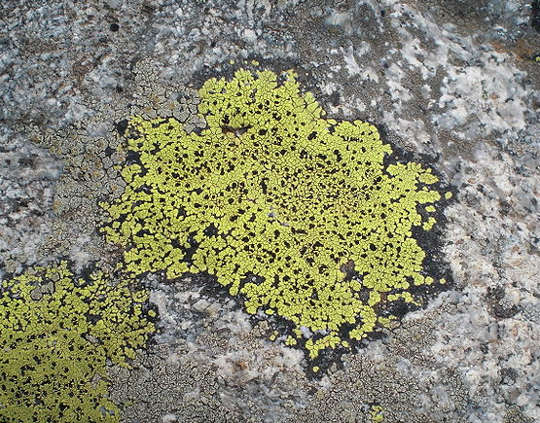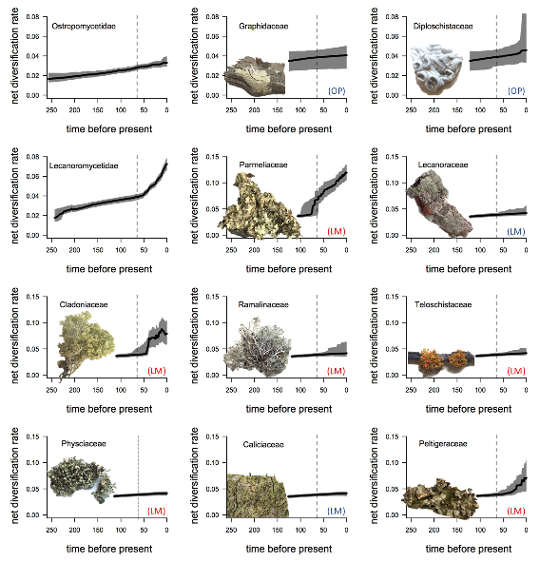This article was published in Scientific American’s former blog network and reflects the views of the author, not necessarily those of Scientific American
As is now pretty well known, a city-sized asteroid hurled itself into Earth near today’s Yucatan Peninsula about 65 million years ago on what was an unquestionably bad day for the planet. But it wasn’t a bad day for everyone.
Although terrifying (not to mention highly injurious to property values), the day that eliminated dinosaurs ultimately produced a slew of creatures that filled their vacated niches. To name but a few: anteaters, antelopes, duck-billed platypuses, slow lorises, giant sloths, saber-toothed tigers, horses, hippopotamuses, humans … and possibly also a whole lot of leafy lichens.
At least, the timing of leafy lichen diversification looks suspiciously as if they may have gotten a big assist from the Big A, according to a new study in Scientific Reports.
On supporting science journalism
If you're enjoying this article, consider supporting our award-winning journalism by subscribing. By purchasing a subscription you are helping to ensure the future of impactful stories about the discoveries and ideas shaping our world today.
Dinosaurs weren’t the only group to take a sucker punch in the summer of Just-Past-66 million BC. Plants, too – large, stationary targets that can’t burrow, jump in the ocean, or relocate easily in response to instant climate change -- struggled to cope. Fungi, on the other hand, often benefited. That isn’t surprising, considering many of them make a living batting cleanup on the dearly departed.
That got a scientist from Chicago's Field Museum wondering: how did lichens fare in the aftermath of the "Terminal Cretaceous Event”? Lichens are leathery or crusty co-ops that marry fungi to algae, some of which are closely related to plants. Did lichens react to the asteroid more like plants or like fungi?
Because the lichen fossil record is skimpy, Thorsten Lumbsch and a team of scientists from the United States, Thailand, and Taiwan decided to investigate by studying lichen DNA. Since the rate of mutation is usually constant, comparing the DNA sequences of various species using special software can help scientists tell how long ago various groups shared a common ancestor and when and how often new species evolved. If lichens prosper, one would expect lots of new species. If not, speciation rates should drop.
But lichens aren’t monolithic; they come in many flavors. One of the most basic ways of classifying them is by size. Macrolichens are big, but also usually leafy or shrubby, like the one pictured at the top of this post.
Microlichens tend to be smaller, crustier affairs, like this:

Credit: Valugi Wikimedia (CC-by-3.0)
The scientists specifically wondered what happened to the speciation rate of macrolichens and microlichens post-asteroid, and published their results in June in the journal Scientific Reports.
When they crunched the DNA data, they concluded that macrolichens in at least three major families blossomed around the time of the impact. Microlichens appear not to have noticed anything happened, and continued making species at the same plodding pace they had pre-asteroid.
In the figure below, families composed predominantly of macrolichens are indicated by red lettering in the lower right corner, and microlichens by blue.

Credit: Huang et al. 2019
At upper left are two larger taxonomic groups called subclasses. Ostropomycetidae contains mostly microlichens, while Lecanoromycetidae is predominantly macrolichens.
However, “around the time of the impact” in this case means anywhere from 100 million to 40 million years ago, so understandably, the asteroid may not have been the only factor in macrolichen diversification. You can see this in the figure above as some groups seem to diversify before or after the black dashed line of doom.
The 60-million-year macrolichen diversification window also encompasses the explosive evolution of flowering plants around 125-80 million years ago, and on the other side of the impact, a significant global warming that peaked at 55 million years ago. Either event may have induced lichens to diversify by providing new homes or more favorable growing conditions.
But it is also possible that the big leafy lichens all diversified simply because, as they were all related, they all inherited a shared propensity to evolve quickly. With the data so far, it’s not possible to distinguish between these possibilities, the scientists say.
Assuming the asteroid did stimulate – or at least contribute to -- macrolichen evolution, why the big leafy lichens and not the small crusty ones?
Epiphytes are plants that grow on other plants. Epiphytic plants would have been particularly vulnerable to the effects of the asteroid, which may have included a global bake at pizza-oven temperatures as tiny glass beads produced by the impact re-entered and heated the atmosphere. Plants rooted in the ground stood some chance of resurrection from underground bits. Epiphytes have no underground bits. On top of that, Earth's climate post-asteroid was probably radically different from what preceded the asteroid for some time.
Thus, it may be that as with so many others, the epiphytic niche opened wide at the dawn of the Paleocene. Tough, dessication-resistant lichens may have survived the planetary flash fry and ensuing climatic trauma much better than Cretaceous ephiphytes. And from the smoking embers, new trees with invitingly naked trunks eventually grew, beckoning nearby lichens to hop onboard.
Reference
Huang, Jen-Pan, Ekaphan Kraichak, Steven D. Leavitt, Matthew P. Nelsen, and H. Thorsten Lumbsch. "Accelerated diversifications in three diverse families of morphologically complex lichen-forming fungi link to major historical events." Scientific reports 9, no. 1 (2019): 8518